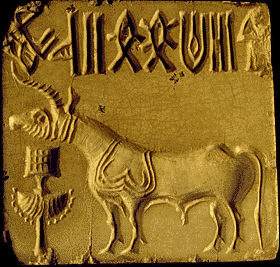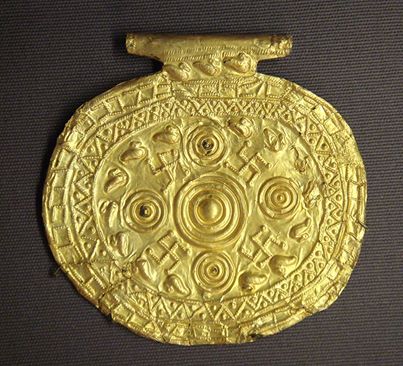Archive for March, 2014
Understanding The Indu-Saraswati Seals
Posted by Kalicharan Tuvij in Language of Morality on March 8, 2014
The Indu-Saraswati seals of archaeological find provide a very keen insight, as also some hard evidence, into the deep Vedic roots of the (H)indu Civilization. The connection between the two: Vedic literature, and archaeological find: is apparently indeed natural, but it could be asked here- why, then, the connection has not been immediately evident to everyone? The answer to this question has more to do with a bad approach to the problem, than the “purported” mal-intent of some to distort an otherwise purely academic discourse.
The problem with the approach has been that it misconstrued the Vedic corpus as a “given” and an accessible resource, while the seals (and the other finds) were “meant” to be something inscrutable, mysterious that needed decoding. The reality, however, turns out to be just the opposite:
The seals- simple creations of artisans- are actually the “given”, whereas it is the Vedic texts that needed the decoding.
This problem is more a home-grown one than a conspiracy theory pointing to some foreign stake-holders:
Hindus have failed to understand the Vedic thought in its true light, and under the spell of relatively recent paradigms such as Vedanta continue to see the Veda as merely something of a ritual-book, karma-kANda. The Vedic Sanskrit (in which the Veda is written) is far richer than the Classical Sanskrit (in which the Vedanta is expressed), and this fact alone- if not anything else- should have alerted them that the quality of content should therefore also be far richer in the Vedic than in the post Vedic.
Anyway, enough on this already; here we will be discussing some of the depictions in the seals alongside an understanding from the Vedic view-point. For the conceptual framework- not much is explained here- the reader is advised to consult other posts of this blog-site.
ADITI and The Four Realms (lokA)
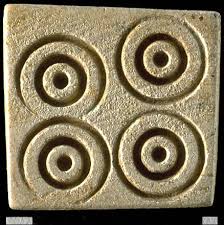
This depiction relates to the Four Realms of Aditi, and the three-fold nature of each Realm is represented by three concentric circles in each of the quadrants. The circles (realms), naturally, also have contact points with the adjacent realms. “Asat” is the state of these realms when they are isolated from each other, whereas “Sat” is the state when these realms communicate with each other via the four contact points between them.
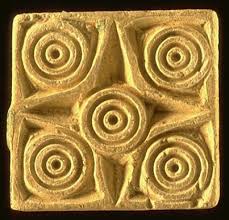
This depiction is a secondary variation of the first one. In addition to the four realms, there is one more shown now in the center, indicative of the “Immortal” consciousness which is placed center of all the realms and their influences.
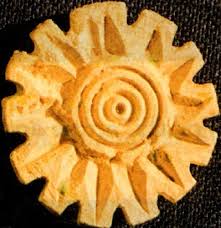
This seal focuses only on one realm, and as before there are three concentric circles, and also the fourth making a boundary giving effect of emanating Sun-rays. The circles therefore can also be seen as some kind of solar deities, also called Aditya-s, or the children of Aditi.

This one is still another variation of the Four Realms, idealized to the extreme by the use of plain straight lines. This symbol is known as Swastika and is the most sacred (certainly more than the AUM) symbol of Hindus.
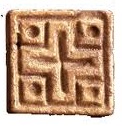
This one is yet another idealized variation of Realms. The circles are not completely abandoned (not even in the present day Swastika) and are depicted as simple dots.

In a related symbology, this seal depicts Vedic God Yama having buffalo-horns (buffalo is His vAhana) for His crown. This goes against the earlier speculations about the figure being that of Shiva/ Rudra, though very few know about the close proximity of the two Vedic Gods Yama and Rudra. As a corroborative we can see four animals surrounding the kingly God: a Tiger (on His left bottom), an Elephant (on His left top), a Rhino (on right top) and a Buffalo (on right bottom). These four animals denote (in the postVedic mythology) the “contact points” between the four realms. Moreover, their sequencing is also right: Tiger is opposite Buffalo (Yama’s own place), and Elephant is opposite Rhino.
Finally, this one, as also discussed earlier in this post, depicts the Vedic God Vayu as an exotic imaginary animal, who is “made up” from an artistic synthesis of many different animals (yes, horse included), receiving Soma juice (soma pavamAna) from an equally exotic “Soma-juice-blender”-cum-“Sacrificial-altar” where the acts of sacrifice (Vedic Yagna) and the receiving of Soma-juice are simultaneously performed and effected. This is also how the communication lines are established between the two (of the four) realms: Heaven (Dyo) and Earth (Prithvi).
Now let us look at the above pendant. Looks like yet another Vedic depiction of Swastika and Aditi’s Realms ? Well, only, this is from Bolsena, Italy ( Etruscan, 700 BC at the farthest). The Indu-Saraswati seals discussed here, however, belong to 3000-2000 BC window. So, the pendant borrows from the Indu-Saraswati which is the source– if we go by the time-scales involved, by the richness and the variety evident of the original design as discussed earlier, and also by how this goes right to the heart and crux of the Vedic thought; finally, the stickiness and exact similarity between the two confirms a faithful transfer of religio-spiritual beliefs (normally associated with actual migrations/invasions of people).
There is more to say, no doubt, but let us leave it here for now.
REFERENCES AND FURTHER EXPLORATION:
4. THE RAMAYANA AND THE ROOTS OF PRE-CHRISTIANITY CIVILIZATION OF ITALY
